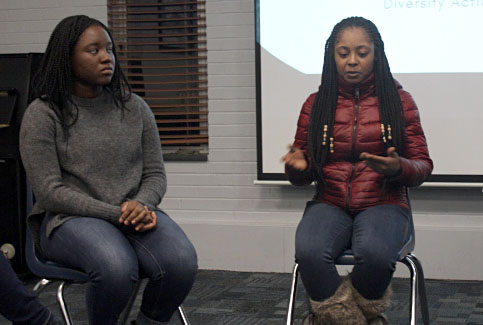Colorism panel held in University Union

Samira Abdoulaye-Pedila (left) and Morgan Colvin (right) discussing diversity in Eastern’s Mattoon/Charleston in the Martin Luther King Jr. University Student Union.
January 28, 2020
A diverse set of faculty, staff and students came together Tuesday night to discuss what colorism means and how it affects people on campus and in the community.
Colorism is used to describe prejudice or discrimination especially within a racial or ethnic group favoring people with lighter skin over those with darker skin, according to Merriam-Webster.
While it shares similarity with racism, the act of discrimination based on race, colorism is mainly used to describe prejudice within inner racial communities.
Luis Paniagua, sophomore graphic design major, began the conversation by talking about the prevalence of colorism with Latino communities.
“Colorism is a big problem in the Latino community, and many don’t know that it’s a thing,” Paniagua said. “They don’t think they can be racist towards each other.”
Paniagua presented a pie chart where he questioned 40 students, who were non-white, about how they felt about colorism.
When asked if they knew what colorism was, over 85 percent answered yes while 15 percent answered no. However, when asked if they believed colorism was still an issue with society, 100 percent of people said yes.
The conversation slowly shifted from colorism to the implementation of safe spaces and then racism and discrimination at Eastern and Charleston as a whole.
Students shared anecdotes of their experiences with harassment based on their race.
Samira Abdoulaye-Pedila, senior psychology major, talked about how she was treated with hostility from white members of the college campus and in Charleston.
When the discussion shifted towards the discussion of safe spaces, Abdoulaye-Pedila brought up how a safe space for her is the expectation of safety within the classrooms and the campus from racial prejudice they experience in their outside life.
“I need to be able to go into a classroom knowing that I’m not going to be treated like how I’ll be treated outside,” Abdoulaye-Pedila said. “I pay to go here; I pay to be in this classroom.”
Most of the students were of African-American, Asian and Latino descent, all of which are statistical minorities in Charleston and Eastern’s student campus, which are all predominantly white.
As of 2017, Charleston’s white population was 83.5 percent, while other demographics were below 10 percent. Charleston’s African-American population is currently at 7.59 percent, the Latino population is 3.83 percent and the Asian population at 1.97 percent, according to datausa.io.
The students concluded that while colorism and racism were equal in terms of how it damages them, colorism feels more personal.
“You’re supposed to feel safe within your people,” Paniagua said.
With issues of racism and colorism, the students came to the idea that as a whole, the best way to handle these situations is by being an ally to people of color as well as holding people accountable for their actions, no matter their race.
“My dad says that we are a more sensitive generation, I say we are more accountable,” said senior political science major Morgan Colvin. “You should always be an ally to someone. We still have a lot more work to do.”
Jalyn Long can be reached at 581-2812 or jnlong@eiu.edu



































































